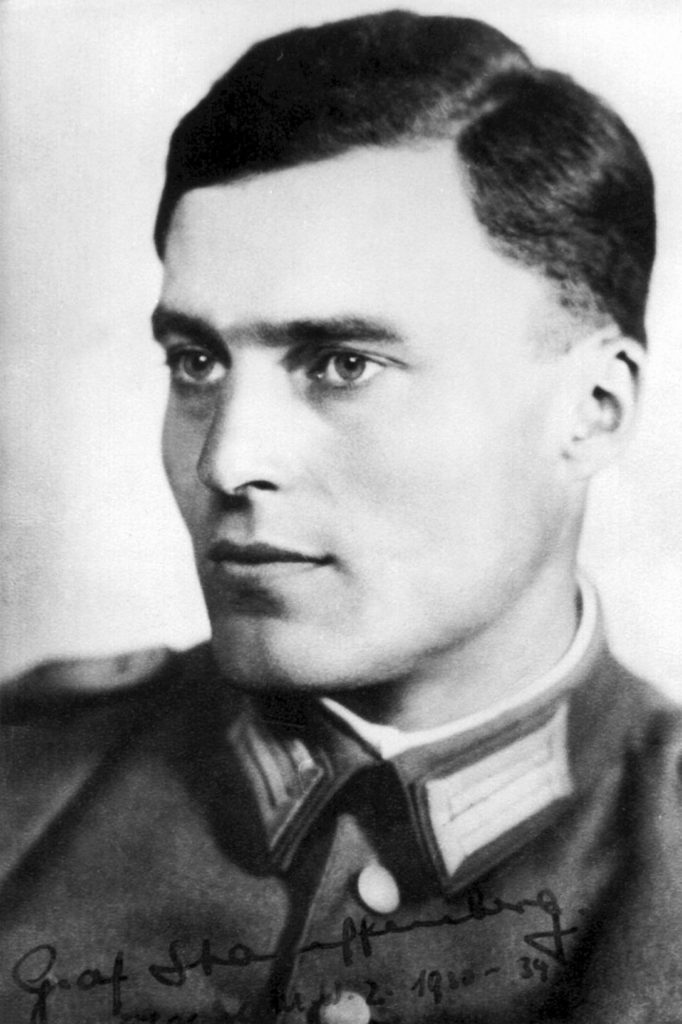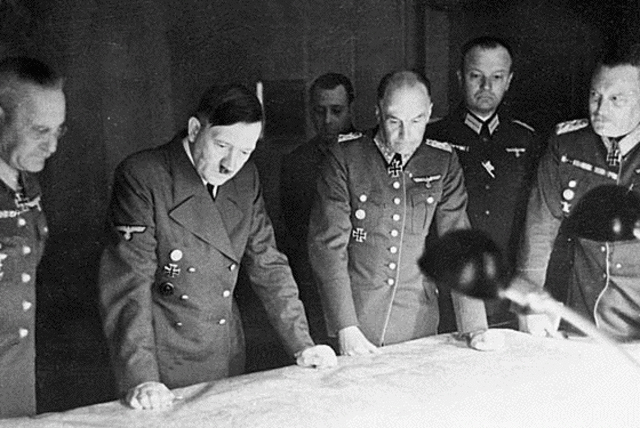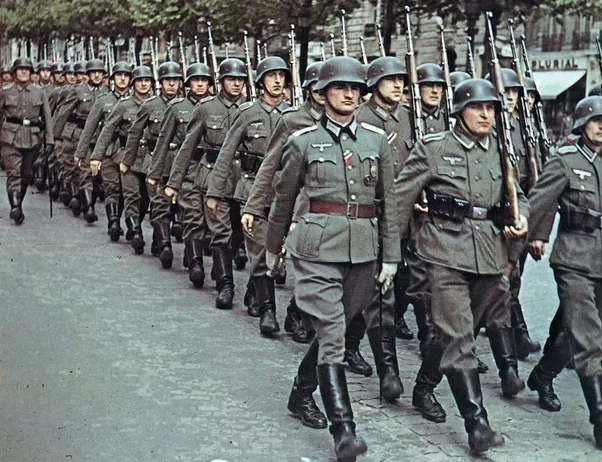 Hello, Owen here, and welcome back to “Nametag Defilade!”
Hello, Owen here, and welcome back to “Nametag Defilade!”
In this multi-part series, we are looking over the Battle of the Bulge and its many facets. From the planning and buildup of forces, the attacks, the men and machines, and the big picture to just a few of the smaller pixel’s worth of stories within. This week, we are going to dive into the reason why the battle took place where it did, what spurred Hitler to attack, and the objective of the battle that followed.
To really understand the Battle of the Bulge and its origins, we must look back almost 5 months, to the culmination of something much smaller in scale but larger in its implication – the July 20th Assassination Plot against Hitler. The mastermind behind the plot, Colonel Claus von Stauffenberg (picture below) , had control of the Ersatzheer or “Replacement Army.” More or less, an army put together to train young soldiers for front-line combat, so trained men could be sent to the front as required. The objective of the July 20th Plot, as von Stauffenberg had planned it, was not just to kill Adolf Hitler, but to use the Ersatzheer to quickly take over the remainder of his government and appeal to the Allies for peace  before more German blood was shed. To accomplish this, von Stauffenberg reduced the Ersatzheer’s replacement rate to a steady trickle, whilst allowing the manpower within it to build up. In the plot, once Hitler was confirmed dead, the now well-reinforced Ersatzheer would take over the major government buildings, subdue the SS, a military branch fiercely loyal to Hitler, and insert a new leader. While this buildup was going on, the slackening number of reinforcements meant the Germans were not able to hold the front lines, and by July, the Allied armies appeared to be poised to break out of the Normandy Beachhead. When the July 20th Plot failed, Von Stauffenberg was executed and the Ersatzheer was taken under new command. The front lines on both the Eastern and Western front solidified as the floodgates for new recruits were re-opened and fresh soldiers were rushed to the front. So great were the numbers that Hitler determined that he could launch an offensive somewhere along the Western front. But where?
before more German blood was shed. To accomplish this, von Stauffenberg reduced the Ersatzheer’s replacement rate to a steady trickle, whilst allowing the manpower within it to build up. In the plot, once Hitler was confirmed dead, the now well-reinforced Ersatzheer would take over the major government buildings, subdue the SS, a military branch fiercely loyal to Hitler, and insert a new leader. While this buildup was going on, the slackening number of reinforcements meant the Germans were not able to hold the front lines, and by July, the Allied armies appeared to be poised to break out of the Normandy Beachhead. When the July 20th Plot failed, Von Stauffenberg was executed and the Ersatzheer was taken under new command. The front lines on both the Eastern and Western front solidified as the floodgates for new recruits were re-opened and fresh soldiers were rushed to the front. So great were the numbers that Hitler determined that he could launch an offensive somewhere along the Western front. But where?

Hitler chose to focus his forces and attack on the Western front for two major reasons.
 First; understanding that nothing significant could happen on the Eastern Front, Hitler believed he could still accomplish one successful attack against what he saw were the inferior US and British armies. A successful attack in the Ardennes would drive a wedge between the two, and perhaps force the US and England to sue for peace separately from the Soviet Union. This would allow Germany to refocus its manpower on the Eastern Front and stall the Russians long enough to develop and procure better weapons against them.
First; understanding that nothing significant could happen on the Eastern Front, Hitler believed he could still accomplish one successful attack against what he saw were the inferior US and British armies. A successful attack in the Ardennes would drive a wedge between the two, and perhaps force the US and England to sue for peace separately from the Soviet Union. This would allow Germany to refocus its manpower on the Eastern Front and stall the Russians long enough to develop and procure better weapons against them.
Second; the Belgian port of Antwerp was strategically important for Allied Logistics. By December 1944, the Allied supply lines were stretched to paper-thinness. Almost 6 months of constant fighting, from D-Day, through the breakout, into the Lorraine Campaign pushing German forces back to the Siegfried Line, had dangerously depleted Allied supplies. Tanks were nearly running on fumes, bullets and shells were meticulously inventoried, and fatigue was taking its toll on the troops. By stopping the advance in the Ardennes after the capture of Antwerp by British forces, troops could rest and recuperate and supplies could be brought in closer to the front. If the Germans Re-captured Antwerp, they would push the supply chain back to the French port of Cherbourg, west of Normandy, and stall Allied operations.
With the objectives laid out, Hitler’s plan was put in place. In the South, Erich Brandenberger’s 7th Army, starting near the town of Ingendorf, would move towards Luxembourg to cut off any flanking attacks. In the center of the German advance, Hasso von Manteuffel’s 5th Panzer Army pushed towards Bastogne and St. Vith, the location of important crossroads and supply junctions. On the northern “shoulder” of the advance, Josef “Sepp” Dietrich’s 6th Panzer Army, which was assembled near the towns of Udenbreth and Hollerath with Nazi Germany’s elite fighting units and most brilliant commanders, was assigned to push through Monschau to the Elsenborn Ridge, and, via the shortest route available, move to capture Antwerp. Leading the 6th Panzer Army’s advance was the First SS Panzer Division’s Obersturmbannführer (Lieutenant Colonel) Joachim Pieper, fitted out with the imposing, newly issued Tiger II heavy tanks and Panzer V “Panther” medium tanks. The attack was to take place in November, while the heavy fog and unpredictable weather in the region would keep the very lethal Allied air forces grounded.
On the Allied side, the Supreme Head of Allied Expeditionary Forces, General Dwight D. Eisenhower, considered his position in the Ardennes to be a strong one. While the roads were stout and easily traversable by armor, the forest surrounding the area was dense and difficult for even infantry to work in. Intelligence indicated that the Germans were using the region as an area to rest. The days leading up to the 16th of December were as normal as ever. Foot patrols went out, keeping the lines secure, a few shots traded with their German counterparts, mostly for appearances, and everyone returning to camp safe and sound.
Allied intelligence services missed a handful of cues that a large buildup was happening in the Ardennes region. Hitler, now reaching the height of his paranoia after the assassination attempt, made use of secure communications lines as much as possible. Movement orders were transmitted via motorcycle courier (although the situation was dire for Germany as the allies closed in, the proximity of the front lines meant more local communications devices and methods could be used, instead of the Enigma machines, which the Germans were suspicious were being intercepted and decoded) or secure phone lines. Some warning signs, like Deutsche Reichsbahn (German State Railways, responsible for rail logistics in wartime) Enigma messages reporting large movements of armored vehicles from Hungary to the Ardennes, were intercepted but the implication was apparently missed.
 On December 14th, a Luxembourgish woman was brought to an American command post in Diekirch with news that large numbers of German field guns and SS soldiers were amassing on the border of Germany and Luxembourg, near the town of Bitburg. This was reported to the US 5th Army Headquarters in Spa, Belgium shortly thereafter.
On December 14th, a Luxembourgish woman was brought to an American command post in Diekirch with news that large numbers of German field guns and SS soldiers were amassing on the border of Germany and Luxembourg, near the town of Bitburg. This was reported to the US 5th Army Headquarters in Spa, Belgium shortly thereafter.
Thank you so much for reading! Join me next week on Nametag Defilade as the Battle of the Bulge kicks off, and we’ll go over the first movements and the allied response!
P.S., I would like to take the time to extend a big “thank you” to the volunteers of the American Heritage Museum that I spoke with after the publishing of my first blog post about the Battle. It’s impossible for one person to know everything about every facet of military history and I appreciate being able to approach all of you with any questions I may have when my research falls short or am just looking for a little bit of discussion and debate. Thank you!!



